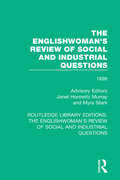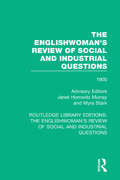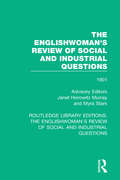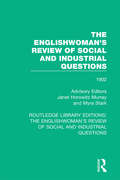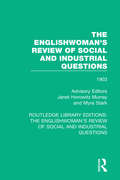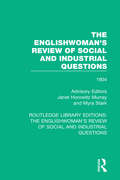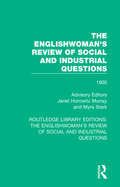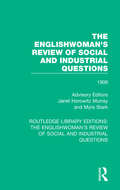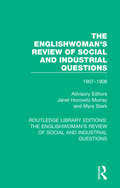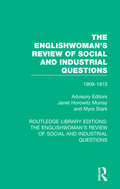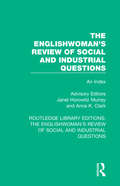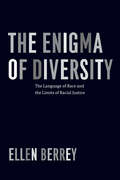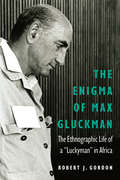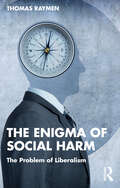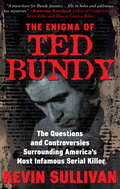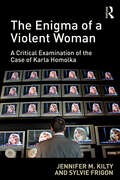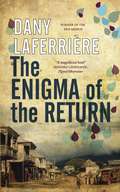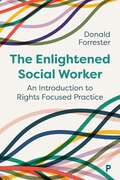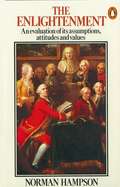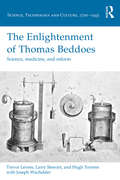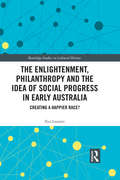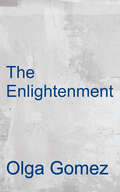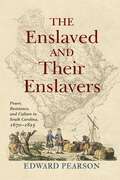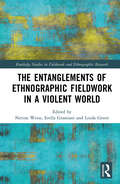- Table View
- List View
The Englishwoman's Review of Social and Industrial Questions: 1899 (Routledge Library Editions: The Englishwoman's Review of Social and Industrial Questions #31)
by Janet Horowitz Murray and Myra StarkThe Englishwoman’s Review, which published from 1866 to 1910, participated in and recorded a great change in the range of possibilities open to women. The ideal of the magazine was the idea of the emerging emancipated middle-class woman: economic independence from men, choice of occupation, participation in the male enterprises of commerce and government, access to higher education, admittance to the male professions, particularly medicine, and, of course, the power of suffrage equal to that of men. First published in 1979, this thirty-first volume contains issues from 1899. With an informative introduction by Janet Horowitz Murray and Myra Stark, and an index compiled by Anna Clark, this set is an invaluable resource to those studying nineteenth and early twentieth-century feminism and the women’s movement in Britain.
The Englishwoman's Review of Social and Industrial Questions: 1900 (Routledge Library Editions: The Englishwoman's Review of Social and Industrial Questions #32)
by Janet Horowitz Murray and Myra StarkThe Englishwoman’s Review, which published from 1866 to 1910, participated in and recorded a great change in the range of possibilities open to women. The ideal of the magazine was the idea of the emerging emancipated middle-class woman: economic independence from men, choice of occupation, participation in the male enterprises of commerce and government, access to higher education, admittance to the male professions, particularly medicine, and, of course, the power of suffrage equal to that of men. First published in 1984, this thirty-second volume contains issues from 1900. With an informative introduction by Janet Horowitz Murray and Myra Stark, and an index compiled by Anna Clark, this set is an invaluable resource to those studying nineteenth and early twentieth-century feminism and the women’s movement in Britain.
The Englishwoman's Review of Social and Industrial Questions: 1901 (Routledge Library Editions: The Englishwoman's Review of Social and Industrial Questions #33)
by Janet Horowitz Murray and Myra StarkThe Englishwoman’s Review, which published from 1866 to 1910, participated in and recorded a great change in the range of possibilities open to women. The ideal of the magazine was the idea of the emerging emancipated middle-class woman: economic independence from men, choice of occupation, participation in the male enterprises of commerce and government, access to higher education, admittance to the male professions, particularly medicine, and, of course, the power of suffrage equal to that of men. First published in 1984, this thirty-third volume contains issues from 1901. With an informative introduction by Janet Horowitz Murray and Myra Stark, and an index compiled by Anna Clark, this set is an invaluable resource to those studying nineteenth and early twentieth-century feminism and the women’s movement in Britain.
The Englishwoman's Review of Social and Industrial Questions: 1902 (Routledge Library Editions: The Englishwoman's Review of Social and Industrial Questions #34)
by Janet Horowitz Murray and Myra StarkThe Englishwoman’s Review, which published from 1866 to 1910, participated in and recorded a great change in the range of possibilities open to women. The ideal of the magazine was the idea of the emerging emancipated middle-class woman: economic independence from men, choice of occupation, participation in the male enterprises of commerce and government, access to higher education, admittance to the male professions, particularly medicine, and, of course, the power of suffrage equal to that of men. First published in 1984, this thirty-fourth volume contains issues from 1902. With an informative introduction by Janet Horowitz Murray and Myra Stark, and an index compiled by Anna Clark, this set is an invaluable resource to those studying nineteenth and early twentieth-century feminism and the women’s movement in Britain.
The Englishwoman's Review of Social and Industrial Questions: 1903 (Routledge Library Editions: The Englishwoman's Review of Social and Industrial Questions #35)
by Anet Horowitz Murray and Myra StarkThe Englishwoman’s Review, which published from 1866 to 1910, participated in and recorded a great change in the range of possibilities open to women. The ideal of the magazine was the idea of the emerging emancipated middle-class woman: economic independence from men, choice of occupation, participation in the male enterprises of commerce and government, access to higher education, admittance to the male professions, particularly medicine, and, of course, the power of suffrage equal to that of men. First published in 1984, this thirty-fifth volume contains issues from 1903. With an informative introduction by Janet Horowitz Murray and Myra Stark, and an index compiled by Anna Clark, this set is an invaluable resource to those studying nineteenth and early twentieth-century feminism and the women’s movement in Britain.
The Englishwoman's Review of Social and Industrial Questions: 1904 (Routledge Library Editions: The Englishwoman's Review of Social and Industrial Questions #36)
by Janet Horowitz Murray and Myra StarkThe Englishwoman’s Review, which published from 1866 to 1910, participated in and recorded a great change in the range of possibilities open to women. The ideal of the magazine was the idea of the emerging emancipated middle-class woman: economic independence from men, choice of occupation, participation in the male enterprises of commerce and government, access to higher education, admittance to the male professions, particularly medicine, and, of course, the power of suffrage equal to that of men. First published in 1984, this thirty-sixth volume contains issues from 1904. With an informative introduction by Janet Horowitz Murray and Myra Stark, and an index compiled by Anna Clark, this set is an invaluable resource to those studying nineteenth and early twentieth-century feminism and the women’s movement in Britain.
The Englishwoman's Review of Social and Industrial Questions: 1905 (Routledge Library Editions: The Englishwoman's Review of Social and Industrial Questions #37)
by Janet Horowitz Murray Myra StarkThe Englishwoman’s Review, which published from 1866 to 1910, participated in and recorded a great change in the range of possibilities open to women. The ideal of the magazine was the idea of the emerging emancipated middle-class woman: economic independence from men, choice of occupation, participation in the male enterprises of commerce and government, access to higher education, admittance to the male professions, particularly medicine, and, of course, the power of suffrage equal to that of men. First published in 1985, this thirty-seventh volume contains issues from 1905. With an informative introduction by Janet Horowitz Murray and Myra Stark, and an index compiled by Anna Clark, this set is an invaluable resource to those studying nineteenth and early twentieth-century feminism and the women’s movement in Britain.
The Englishwoman's Review of Social and Industrial Questions: 1906 (Routledge Library Editions: The Englishwoman's Review of Social and Industrial Questions #38)
by Janet Horowitz Murray Myra StarkThe Englishwoman’s Review, which published from 1866 to 1910, participated in and recorded a great change in the range of possibilities open to women. The ideal of the magazine was the idea of the emerging emancipated middle-class woman: economic independence from men, choice of occupation, participation in the male enterprises of commerce and government, access to higher education, admittance to the male professions, particularly medicine, and, of course, the power of suffrage equal to that of men. First published in 1985, this thirty-eighth volume contains issues from 1906. With an informative introduction by Janet Horowitz Murray and Myra Stark, and an index compiled by Anna Clark, this set is an invaluable resource to those studying nineteenth and early twentieth-century feminism and the women’s movement in Britain.
The Englishwoman's Review of Social and Industrial Questions: 1907-1908 (Routledge Library Editions: The Englishwoman's Review of Social and Industrial Questions #39)
by Janet Horowitz Murray Myra StarkThe Englishwoman’s Review, which published from 1866 to 1910, participated in and recorded a great change in the range of possibilities open to women. The ideal of the magazine was the idea of the emerging emancipated middle-class woman: economic independence from men, choice of occupation, participation in the male enterprises of commerce and government, access to higher education, admittance to the male professions, particularly medicine, and, of course, the power of suffrage equal to that of men. First published in 1985, this thirty-ninth volume contains issues from 1907 to 1908. With an informative introduction by Janet Horowitz Murray and Myra Stark, and an index compiled by Anna Clark, this set is an invaluable resource to those studying nineteenth and early twentieth-century feminism and the women’s movement in Britain.
The Englishwoman's Review of Social and Industrial Questions: 1909-1910 (Routledge Library Editions: The Englishwoman's Review of Social and Industrial Questions #40)
by Janet Horowitz Murray Myra StarkThe Englishwoman’s Review, which published from 1866 to 1910, participated in and recorded a great change in the range of possibilities open to women. The ideal of the magazine was the idea of the emerging emancipated middle-class woman: economic independence from men, choice of occupation, participation in the male enterprises of commerce and government, access to higher education, admittance to the male professions, particularly medicine, and, of course, the power of suffrage equal to that of men. First published in 1985, this fortieth volume contains issues from 1909 to 1910. With an informative introduction by Janet Horowitz Murray and Myra Stark, and an index compiled by Anna Clark, this set is an invaluable resource to those studying nineteenth and early twentieth-century feminism and the women’s movement in Britain.
The Englishwoman's Review of Social and Industrial Questions: An Index (Routledge Library Editions: The Englishwoman's Review of Social and Industrial Questions #41)
by Janet Horowitz Murray Anna K. ClarkThe Englishwoman’s Review, which published from 1866 to 1910, participated in and recorded a great change in the range of possibilities open to women. The ideal of the magazine was the idea of the emerging emancipated middle-class woman: economic independence from men, choice of occupation, participation in the male enterprises of commerce and government, access to higher education, admittance to the male professions, particularly medicine, and, of course, the power of suffrage equal to that of men. First published in 1985, this final volume contains the index, which was compiled from the Table of Contents which appeared at the front of the yearly volumes. Along with the informative introduction, the index is a helpful tool for those studying the vast quantity of original material collected in the set, making it an invaluable resource to those studying nineteenth and early twentieth-century feminism and the women’s movement in Britain.
The Enigma of Diversity: The Language of Race and the Limits of Racial Justice
by Ellen BerreyDiversity these days is a hallowed American value, widely shared and honored. That's a remarkable change from the Civil Rights era--but does this public commitment to diversity constitute a civil rights victory? What does diversity mean in contemporary America, and what are the effects of efforts to support it? Ellen Berrey digs deep into those questions in The Enigma of Diversity. Drawing on six years of fieldwork and historical sources dating back to the 1950s and making extensive use of three case studies from widely varying arenas--housing redevelopment in Chicago's Rogers Park neighborhood, affirmative action in the University of Michigan's admissions program, and the workings of the human resources department at a Fortune 500 company--Berrey explores the complicated, contradictory, and even troubling meanings and uses of diversity as it is invoked by different groups for different, often symbolic ends. In each case, diversity affirms inclusiveness, especially in the most coveted jobs and colleges, yet it resists fundamental change in the practices and cultures that are the foundation of social inequality. Berrey shows how this has led racial progress itself to be reimagined, transformed from a legal fight for fundamental rights to a celebration of the competitive advantages afforded by cultural differences. Powerfully argued and surprising in its conclusions, The Enigma of Diversity reveals the true cost of the public embrace of diversity: the taming of demands for racial justice.
The Enigma of Max Gluckman: The Ethnographic Life of a "Luckyman" in Africa (Critical Studies in the History of Anthropology)
by Robert J. GordonThe Enigma of Max Gluckman examines one of the most influential British anthropologists of the twentieth century. South African–born Max Gluckman was the founder of what became known as the Manchester School of social anthropology, a key figure in the anthropology of anticolonialism and conflict theory in southern Africa, and one of the most prolific structuralist and Marxist anthropologists of his generation. From his position at Oxford University as graduate student and lecturer to his career at Manchester, Gluckman was known to be generous and engaged with his closest colleagues but brutish and hostile in his denunciations of their work if it did not contribute to the social justice and activist vision he held for the discipline. Conventional histories of anthropology have treated Gluckman as an outlier from mainstream British social anthropology based on his career at the University of Manchester and his gruff manner. He was certainly not the colonial gentleman typical of his British colleagues in the field. Gluckman was deeply engaged with field research in southern Africa on the Zulus, in Barotseland with the Lozi, and also in connection with his directorship of the Rhodes-Livingstone Institute from 1941 to 1947, which obscured his growing critique of anthropology’s methods and ties to Western colonialism and racial oppression in the subcontinent. Robert J. Gordon’s biography skillfully reexamines the colorful life of Max Gluckman and restores his career in the British anthropological tradition.
The Enigma of Social Harm: The Problem of Liberalism
by Thomas RaymenDrawing on a novel blend of moral philosophy, social science, psychoanalytic theory and continental philosophy, this book offers up a diagnosis of contemporary liberal capitalist society and the increasingly febrile culture we occupy when it comes to matters of harm. On what basis can we say that something is harmful? How are we supposed to judge between competing opinions on the harmfulness of a particular behaviour, practice, or industry? Can we avoid drifting off into relativism when it comes to judgements about harm? In an age of deep cultural and political discord about what is and is not harmful, providing answers to such questions is more important than ever. Appraising the current state of the concept of social harm in academic scholarship and every-day life, Thomas Raymen finds a concept in an underdeveloped state of disorder, trapped in interminable deadlocks and shrill disagreements about what should and should not be considered harmful. To explain the genesis of this conceptual crisis and identify what we need to do to resolve it, The Enigma of Social Harm travels from Graeco-Roman antiquity to the present day, exploring trends and developments in moral and political philosophy, religion, law, political economy, and culture. Along the way, we see how such trends and developments have not only made it more difficult to establish a shared basis for evaluating harm, but that the tools which might enable us to do so are now outright prohibited by the political-economic, cultural, and ethical ideology of liberalism that dominates contemporary society. Written in a clear and accessible style, it is essential reading for all those interested in matters of social harm, justice, politics, and ethics.
The Enigma of Ted Bundy: The Questions and Controversies Surrounding America's Most Infamous Serial Killer
by Kevin M. Sullivan&“A must-have for Bundy fanatics, this collection fills in holes and addresses key mysteries about of one of the world&’s most infamous serial killers.&” —Katherine Ramsland, bestselling author of Confession of a Serial Killer Within these pages, you&’ll read of the many questions still surrounding this fascinating and intricate case, as well as the answers that are only now being provided here. There&’s so much more to learn, and new information is still surfacing about Bundy, his victims and his potential victims. As such, there is new testimony included from those who had a brush with the killer, and others who played their own roles in this multi-state case. In this book, Bundy case detectives Jerry Thompson of Salt Lake City, Utah, and Don Patchen of Tallahassee, Florida, talk about their personal experiences with Bundy. So does Ron Holmes, the Louisville criminologist who worked with the killer towards the end of his life. Also included are official reports that have rarely been viewed outside of the archives, along with the author&’s commentary to guide readers through them. And last but not least, is Bundy&’s final confession to Utah detective Dennis Couch just hours prior to Bundy&’s execution. In it, Bundy reveals startling facts and sparks additional questions. A must-read for those true crime readers fascinated by America&’s most enigmatic and infamous serial killer. Praise for Kevin M. Sullivan&’s books on Ted Bundy &“Provides the most in-depth examination of the killer and his murders ever conducted.&” —Dan Zupansky, host of the True Murder podcast &“This is crime writing at its very best!&” —Gary C. King, author of The Murder of Meredith Kercher
The Enigma of a Violent Woman: A Critical Examination of the Case of Karla Homolka
by Jennifer M. Kilty Sylvie FrigonKarla Homolka has proven to be a figure of enduring interest to the public and media for the last 20 years. However, despite the widespread Canadian and international public commentary and media frenzy that has encircled this case, Homolka herself remains an enigma to most who write about her. In contrast to much of the contemporary discussion on this case, this book offers a comprehensive and detailed examination of the legal, public and media understandings and explanations of Homolka’s criminality. Drawing from multiple fields of study and varied bodies of critical literature, the book uses Homolka as an object lesson to interrogate some of the narratives and conceptualizations of ‘violent women’, the problematic normative constructions of womanhood and ‘acceptable femininity’, leniency in sentencing, taboo and disgust, and questions of remorse. The authors address broad questions about how women convicted of violence are typically constructed across four sites: the courts; the academy; the mainstream media; and public discourse. This unique text is extremely important for feminist criminology and socio-legal studies, offering the first comprehensive academic effort to engage in dialogue about this important and fascinating case.
The Enigma of the Return
by Dany Laferrière"An affecting meditation on loss and exile" ANGEL GURRIA-QUINTANA, Financial TimesWindsor Laferrière left Haiti in fear of his life. He has lived in Montreal for thirty-three years, and when his father dies in New York, himself an exile for half a century, Windsor travels there to attend the funeral, and then back to Haiti to inform his mother of the death. In Haiti, Windsor is faced with the grim truth of life in his homeland - the endemic poverty, the thwarted ambitions and broken dreams. But only here can he become a writer again . . .The Enigma of the Return lives where fiction, poetry and autobiography meet. These creative tensions sustain a narrative of astonishing beauty, clarity and insight."Looks set to become one of the great poetic statements of homesickness and return . . . It should be read by all exiles everywhere" Ian Thomson, Independent"A poetic, melancholic tour de force . . . a compelling, intense, stark and poignant exploration of living life as an outsider . . . The great Haitian novel" Jo Lateu, New Internationalist
The Enigma of the Return
by Dany Laferrière"An affecting meditation on loss and exile" ANGEL GURRIA-QUINTANA, Financial TimesWindsor Laferrière left Haiti in fear of his life. He has lived in Montreal for thirty-three years, and when his father dies in New York, himself an exile for half a century, Windsor travels there to attend the funeral, and then back to Haiti to inform his mother of the death. In Haiti, Windsor is faced with the grim truth of life in his homeland - the endemic poverty, the thwarted ambitions and broken dreams. But only here can he become a writer again . . .The Enigma of the Return lives where fiction, poetry and autobiography meet. These creative tensions sustain a narrative of astonishing beauty, clarity and insight."Looks set to become one of the great poetic statements of homesickness and return . . . It should be read by all exiles everywhere" Ian Thomson, Independent"A poetic, melancholic tour de force . . . a compelling, intense, stark and poignant exploration of living life as an outsider . . . The great Haitian novel" Jo Lateu, New Internationalist
The Enlightened Social Worker: An Introduction to Rights-Focused Practice
by Donald ForresterWhile social work theory tends to emphasise helping individuals and challenging social injustice, the reality of practice is characterised by challenge and conflict. This text offers a new concept of social work that explains the nature of these conflicts and moves beyond them, with an inspiring and practical vision of what social work is and should be. Placing rights at the heart of practice, this introduction to social work will be useful to practitioners and students with a substantive contribution to the theoretical literature that emphasises the role of social work when rights may be in conflict, enabling students and workers to become more confident in dealing with the uncomfortable realities of practice.
The Enlightenment
by Norman HampsonArmed with the insights of the scientific revolution, the men of the Enlightenment set out to free mankind from its age-old cocoon of pessimism and superstition and establish a more reasonable world of experiment and progress. Yet by the 1760s, this optimism about man and society had almost evaporated. In the works of Rousseau, Kant and Goethe, there was discernible a new inner voice, and an awareness of individual uniqueness which had eluded their more self-confident predecessors. The stage was set for the revolutionary crisis and the rise of Romanticism. In this book, Norman Hampson follows through certain dominant themes in the Enlightenment, and describes the contemporary social and political climate, in which ideas could travel from the salons of Paris to the court of Catherine the Great - but less easily from a master to his servant. On such vexed issues as the role of ideas in the "rise of the middle class" he provides a new and realistic approach linking intellectual and social history.
The Enlightenment of Thomas Beddoes: Science, medicine, and reform (Science, Technology and Culture, 1700-1945)
by Larry Stewart Joseph Wachelder Trevor Levere Hugh TorrensThomas Beddoes (1760-1808) lived in ‘decidedly interesting times’ in which established orders in politics and science were challenged by revolutionary new ideas. Enthusiastically participating in the heady atmosphere of Enlightenment debate, Beddoes' career suffered from his radical views on politics and science. Denied a professorship at Oxford, he set up a medical practice in Bristol in 1793. Six years later - with support from a range of leading industrialists and scientists including the Wedgwoods, Erasmus Darwin, James Watt, James Keir and others associated with the Lunar Society - he established a Pneumatic Institution for investigating the therapeutic effects of breathing different kinds of ‘air’ on a wide spectrum of diseases. The treatment of the poor, gratis, was an important part of the Pneumatic Institution and Beddoes, who had long concerned himself with their moral and material well-being, published numerous pamphlets and small books about their education, wretched material circumstances, proper nutrition, and the importance of affordable medical facilities. Beddoes’ democratic political concerns reinforced his belief that chemistry and medicine should co-operate to ameliorate the conditions of the poor. But those concerns also polarized the medical profession and the wider community of academic chemists and physicians, many of whom became mistrustful of Beddoes’ projects due to his radical politics. Highlighting the breadth of Beddoes’ concerns in politics, chemistry, medicine, geology, and education (including the use of toys and models), this book reveals how his reforming and radical zeal were exemplified in every aspect of his public and professional life, and made for a remarkably coherent program of change. He was frequently a contrarian, but not without cause, as becomes apparent once he is viewed in the round, as part of the response to the politics and social pressures of the late Enlightenment.
The Enlightenment, Philanthropy and the Idea of Social Progress in Early Australia: Creating a Happier Race? (Routledge Studies in Cultural History #63)
by Ilya LazarevThis book seeks to highlight the influence of the Enlightenment idea of social progress on the character of the "civilising mission" in early Australia by tracing its presence in the various "civilising" attempts undertaken between 1788 and 1850. It also represents an attempt to marry the history of the British Enlightenment and the history of settler-Aboriginal interactions. The chronological structure of the book, as well as the breadth of its content, will facilitate the readers’ understanding of the evolution of "civilising attempts" and their epistemological underpinnings, while throwing additional light on the influence of the Enlightenment on Australian history as a whole.
The Enlightenment: A Sourcebook and Reader
by Olga GomezThe Enlightenment brings together the work of major Enlightenment thinkers such as Hobbes, Rousseau, Diderot and Kant, to illustrate the full importance and achievements of this period in history. Extracts are gathered thematically into sections on such aspects of the Enlightenment as: political theory religion and belief art and nature. All essays are introduced, and a final section on 'critical reflections' provides a selection of modern critical opinions on the period by writers including Foucault, Habermas, and Lyotard. Containing illustrations from the work of artists such as Hogarth and Gainsborough, a chronology of the Enlightenment, and a detailed bibliography, The Enlightenment is a rich source of information and inspiration for all those studying this great period of change.
The Enslaved and Their Enslavers: Power, Resistance, and Culture in South Carolina, 1670–1825
by Edward PearsonIn The Enslaved and Their Enslavers, Edward Pearson offers a sweeping history of slavery in South Carolina, from British settlement in 1670 to the dawn of the Civil War. For enslaved peoples, the shape of their daily lives depended primarily on the particular environment in which they lived and worked, and Pearson examines three distinctive settings in the province: the extensive rice and indigo plantations of the coastal plain; the streets, workshops, and wharves of Charleston; and the farms and estates of the upcountry. In doing so, he provides a fine-grained analysis of how enslaved laborers interacted with their enslavers in the workplace and other locations where they encountered one another as plantation agriculture came to dominate the colony.The Enslaved and Their Enslavers sets this portrait of early South Carolina against broader political events, economic developments, and social trends that also shaped the development of slavery in the region. For example, the outbreak of the American Revolution and the subsequent war against the British in the 1770s and early 1780s as well as the French and Haitian revolutions all had a profound impact on the institution’s development, both in terms of what enslaved people drew from these events and how their enslavers responded to them.Throughout South Carolina’s long history, enslaved people never accepted their enslavement passively and regularly demonstrated their fundamental opposition to the institution by engaging in acts of resistance, which ranged from vandalism to arson to escape, and, on rare occasions, organizing collectively against their oppression. Their attempts to subvert the institution in which they were held captive not only resulted in slaveowners tightening formal and informal mechanisms of control but also generated new forms of thinking about race and slavery among whites that eventually mutated into pro-slavery ideology and the myth of southern exceptionalism.
The Entanglements of Ethnographic Fieldwork in a Violent World (Routledge Studies in Fieldwork and Ethnographic Research)
by Erella Grassiani Linda Green Nerina WeissThis book focuses on the emotional hazards of conducting fieldwork about or within contexts of violence and provides a forum for field-based researchers to tell their stories. Increasingly novice and seasoned ethnographers alike, whether by choice or chance, are working in situations where multidimensional forms of violence, conflict and war are facets of everyday life. The volume engages with the methodological and ethical issues involved and features a range of expressive writings that reveal personal consequences and dilemmas. The contributors use their emotions, their scars, outrage and sadness alongside their hopes and resilience to give voice to that which is often silenced, to make visible the entanglements of fieldwork and its lingering vulnerabilities. The book brings to the fore the lived experiences of researchers and their interlocutors alike with the hope of fostering communities of care. It will be valuable reading for anthropologists and those from other disciplines who are embarking on ethnographic fieldwork and conducting qualitative empirical research.
